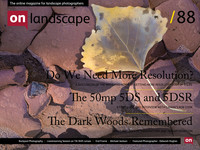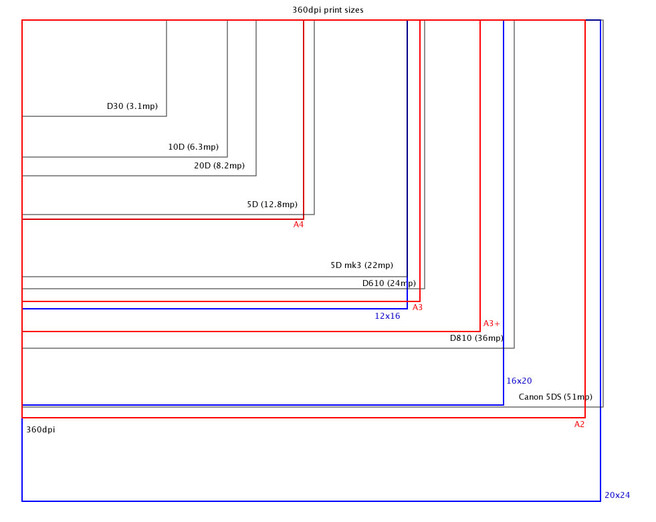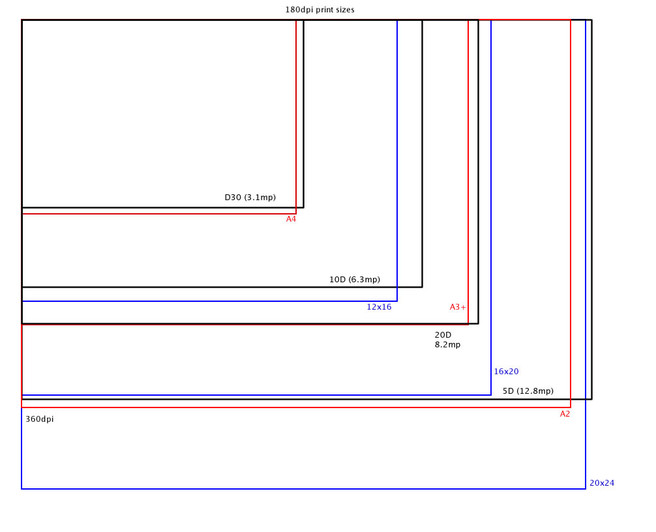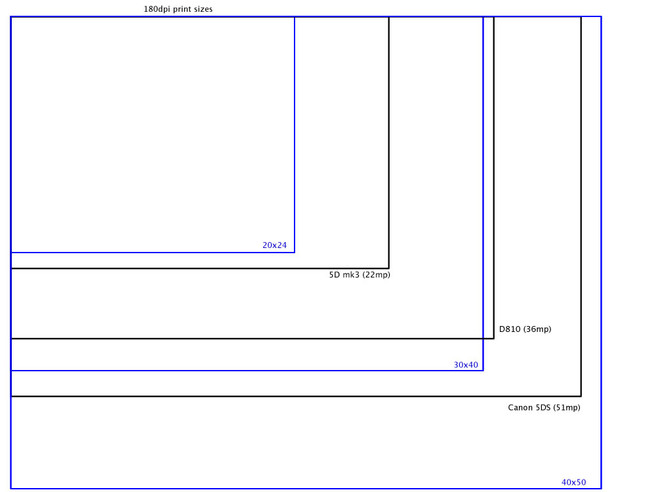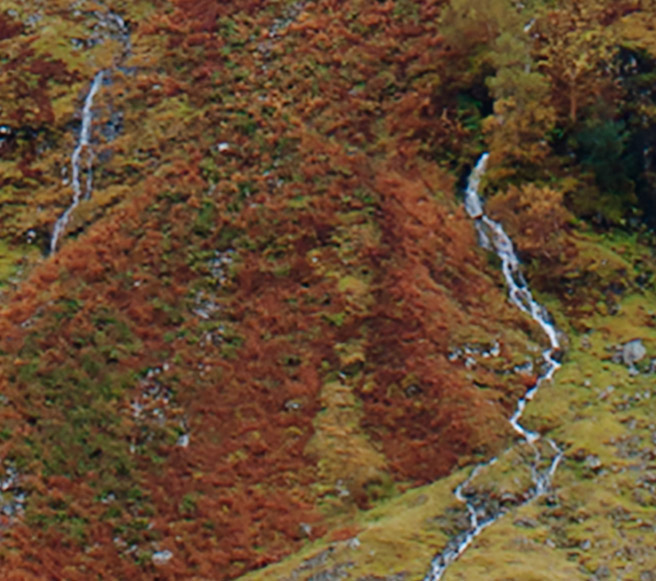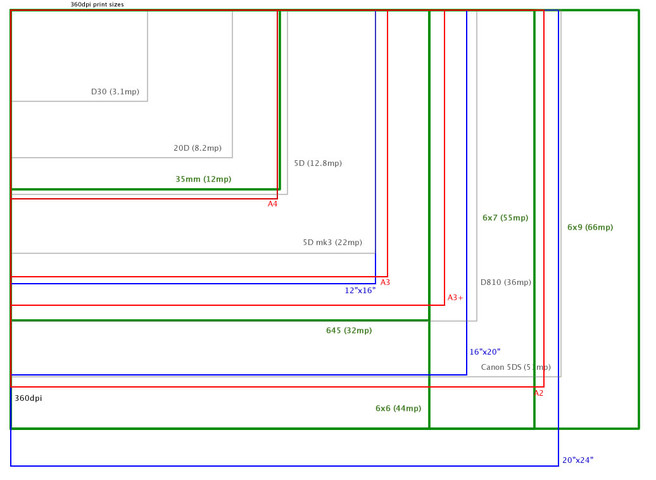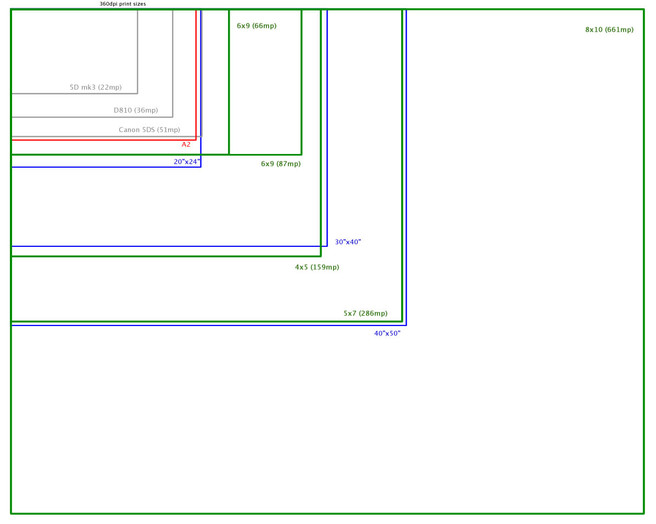How much is enough?

Tim Parkin
Amateur Photographer who plays with big cameras and film when in between digital photographs.
There have been two constant declarations from photographers ever since the first digital camera appeared. The first was that they have "more resolution than film!" (even 3mp cameras!) and the second is that "it's as much as we need". As each increase in resolution of digital cameras increase, from 3 to 6 to 8, 10, 12 and more recently 24 and 36 megapixels - a substantial number of photographers would ask "Why do we need such resolution? I print skyscraper-sized prints from my current camera!".
Well on the one hand they are right - the world lived with badly scanned 35mm film for quite a while and they would probably only equate to about 6mp so anything more than this is perhaps excessive. However, there are very few photographers, especially landscape photographers, who would be happy to go back the the same quality cameras as their first digital cameras.
On the other hand the number of landscape photographers who have bought the 36mp Sony and Nikon shows that there is a strong demand. And in my opinion I agree that, with all things being equal, more resolution will always be useful. You never know which photograph you take is going to be the one chosen by the guy who wants full bleed wall coverings for their penthouse office. I was asked a while back to make an image that would be printed at 8m by 3m and even with the current 36mp crop of cameras this would only give you a 23dpi print (or approx one pixel per mm). Now this is extreme but even stitch of portrait images would only give 60dpi. Any improvement on this has to be welcome.
So just for a minute let us take a look at how big we can print at 300dpi from the various cameras. I've made three diagrams - the first is for 360dpi (typical Epson print resolution) and the second at 180dpi which is usually the lowest most people would want to go without losing too much detail. Here's the 360dpi one..
and here's the two 180dpi ones. There was too much detail for a single picture so the first is for smaller print sizes and the second for large sizes.
So you can see here that the jump from the 5D2 to the 5D3 looks like a bigger increase in print size than the jump from D800 to the 5DS. the first was an increase of 30% in print size and the latter an increase in 20%. If you're jumping directly from a 5D3 to a 5DS though it's a 50% increase in print size.
We need to look at whether this whole 50% increase in print resolution is achievable and we we need to look at just what aspects can limit increased resolution.
Lens Quality
Most people are saying that "the lenses cannae take it, Captain!". OK - not everybody is doing so in a Scotty accent but there is a widely held belief that the lenses available are just not up to scratch for anything above 36mp. Now they said the same thing about 36mp when the D800 came out but we'll ignore this and take a proper look.
We can kill this myth quite quickly by looking at Zeiss's tests of their 50mm lens where they managed to get 400 line pairs per mm in the middle of the frame. In terms of how many pixels we would need to be able to make the most of this on the 35mm camera we get a frame width of 28,800px and a frame height of 19,200px.
That's about 550mp! We're OK for a while with current lenses then ... Well with the wide angle lens we can get 400lpmm too (Zeiss Biogon 25mm). It turns out that the 400lpmm value is the maximum possible at the f/4 tested - i.e. it's "diffraction limited". (p.s. this value wasn't theoretical either, it was actually recorded on film!)
Now corners are a different matter but if we remind ourselves that a lens only needs to resolve 120lpmm to match the new 50mp crop of DSLR cameras. It would be surprising if the centre sharpness of 400lpmm dropped more than 75%!
And now we move onto the other killer:
Diffraction
Diffraction has been a bugbear of the digital age. Whenever anyone tests a lens and things start to blur at smaller apertures, everyone shouts diffraction and declares a 'hard limit' in terms of sharpness/resolution. Well just to debunk another myth - When your images get softer as you stop down, it isn't some brick wall of diffraction you are encountering - every lens at every aperture suffers from diffraction. A lens only gets soft when the combination of the lenses natural sharpness and increasing diffraction reduce the resolution until it's too much to get definition between your cameras pixels.
Well here's the rub - if you've read our previous article on diffraction, you'll know that a 36mp camera at f/22 is sharper than a 24mp camera at f/16!! So is it should be no surprise that a 50mp camera at f/22 will be sharper than a 24mp camera at f/16. This is because the sharpness of a system is the combination of all the influences - lens resolution, diffraction, anti-alias filter, sensor resolution, etc. Increase any one of these and your overall sharpness increases. It should also be added that all lenses aren't equal at f/16 or even f/22 (at f/16 you can get up to 20% difference in resolution between a good lens and an average lens, and at f/22 a 10% difference isn't uncommon)!
So diffraction is an issue and you are definitely better using larger apertures but it isn't a hard limit that restricts f/11 shots to 30mp (or whatever!)
Depth of field
Given that we're talking about diffraction, in landscape work we very often want front to back sharpness. In order to get this we stop down our lenses, quite often to f/11, f/16 or (even to f/22 if we're insane or we really know what we want!). Diffraction becomes a resolution restricting feature at about f/8 or more so aren't we going to lose resolution when we have to stop down for depth of field? Well, yes. But! As mentioned earlier, an f/16 shot on a 50mp sensor is still sharper than an f/16 shot on a 36mp sensor.
You can't escape from the fact that it's an issue though. So how do people get around this to capture ultra high resolution images - if we look at the large format world, they use tilt. This isn't a miracle cure but most LF shots are taken somewhere between f/22 and f/45. In DSLR terms these apertures are f/5.6 and f/8
Bayer Array
In the perfect world, a photograph from a 21mp camera would look the same as one from a 50mp camera downsampled to 21mp. However this is definitely not true for our typical DSLR. The way that this typical DSLR records colour means that colour information is recorded at different resolutions to luminance information. For instance, a photograph of a map drawn in red lines on a light grey background would only be recorded at 1/2 of the resolution of a map in green on grey and a 1/4 of the resolution of a map in black on a white background. Most of the time, because of the way colour is distributed in the real world, we don't notice this having an effect. But it does and it shows up quite obviously in some pictures. We plan to test this on the 5DS against a 5D3 when we get our hands on it but the comparison can be made by taking a photograph with two different focal lengths and then downsampling the longer focal length by 50% and comparing the results (I've included an example I dug out of my Glencoe trip - take a look at the bracken at the left of the image and note the colour changes).
Shutter
This one is well known. A bouncy shutter can cause softness at certain shutter speeds and in certain orientations. The A7R has problems in portrait orientation with longer lenses. Canon have added a servo controlled mirror on the 5DS to minimise this (but not included electronic shutter control for some reason). The 5DS also has a custom delay between mirror lock up and taking the shot. This means you only have to press the shutter once and you can set the delay to anywhere from 0.125s to 2s depending on the photography you do (big lens maybe needs more?)
Noise
No camera is noiseless but you can reduce noise by using a higher resolution and downsizing. A lot of the issues around noise are do to with sensor design and as such are out of our control. But for maximum resolution we want to minimise noise (which may mean two shots as things in the shadows will have less resolution than things exposed normally because of noise)
Joe Wright commented that I had not included film cameras in the results so I went back to our Big Camera Comparison and recent article about medium format film and DSLRs and produced the following two diagrams. I've split it into two because including 10x8 in one diagram makes everything else illegible. The results are based on actual side by side comparisons of scans against digital images - not the maximum resolution we could scan at (i.e. 3000dpi is generally considered the amount of detail in most consumer films - although to get this you typically have to oversample and hence scan at up to 5000dpi. The 8x10 result was limited to 2000dpi as this is usually the maximum resolution scan photographers have and generates an unwieldy 2Gb as it is)
This article is currently active so if you've got anything you'd like me to add or thoughts about what I've already written, please add comments below and I'll get back asap.
Read our latest article on testing the Canon 5DSr click here.

